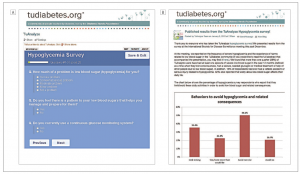
Sharing via social media is a great opportunity for collecting better public health data and encouraging healthy behavior changes. (bengrey/Flickr)
We humans are sharing creatures. We talk about ourselves, what we think, what we know. If we weren’t like this, cocktail parties would be really boring, and Facebook and Twitter wouldn’t exist.
Nor would health care. At the most basic level, health care relies on give-and-take between patients and doctors—patients sharing their symptoms and concerns with doctors, and doctors sharing their knowledge with patients.
The same holds true for public health. Prevention and control efforts require lots of patients and doctors to share information so that public health agencies know where to target their resources.
But the give-and-take in public health is often slow and cannot always detect conditions or complications at rates that reflect reality. And usually it’s one-way—from the patient or public to surveyors.
Making disease surveillance a conversation
Kenneth Mandl, MD, MPH, and Elissa Weitzman, ScD, MSc, of our informatics program’s Intelligent Health Laboratory understand these gaps all too well. In response, they’ve advocated for a “participatory” approach to public health surveillance, one that relies largely on social media platforms.
“Participatory surveillance establishes a bidirectional communications link between public health and consumers,” says Mandl, who directs the IHL. “It lets us tap the community for crowd-sourced information, but also feed results back and implement behavior change strategies. We see it as a new model for public health reporting across conditions and health issues.”
The diabetes example
Participatory surveillance taps the community for crowd-sourced information and feeds results back and implement behavior change strategies.
Weitzman and Mandl have spent the last couple of years testing this approach in patients with diabetes. Together with the Diabetes Hands Foundation, the pair is collecting diabetes surveillance data from members of a social network called TuDiabetes.org using an online app called TuAnalyze. The app allows TuDiabetes community members to share information about their health status with researchers and, if they choose, with the rest of the community.
That sharing began with information about their hemoglobin A1C status, a health metric used to measure long-term diabetes control.
Now Weitzman and Mandl are using TuAnalyze to look at an under-studied aspect of diabetes: episodes of hypoglycemia, or low blood sugar. At the moment, hypoglycemia surveillance data only come from emergency rooms reports and clinical trials.
“We don’t know much about how populations with diabetes in general experience insulin effects and complications like hypoglycemia,” Weitzman, a social-behavioral scientist, said in a recent press release. “Insulin is widely used, but we don’t have a grasp of how many patients experience hypoglycemic episodes that are not severe enough to merit emergency treatment.”
Results and reactions
Using TuAnalyze, Weitzman and Mandl found just how much hypoglycemia is being underestimated. In a paper just published in JAMA Internal Medicine (you can read the abstract here), they report that in a 613-person sample of TuAnalyze users, more than half said they had “gone low” in the previous two weeks, and about 30 percent had experienced a severe hypoglycemic episode, such as one causing them to pass out or have a seizure. More than half of the respondents also reported other health and lifestyle impacts related to hypoglycemia or worries about it.

The TuAnalyze team's hypoglycemia survey and research blog. The blog lets them feed aggregated results back to the community quickly and encourage action.
“Because there are no gold-standard data sets or national tracking systems in place for hypoglycemia, we don’t have a solid baseline against which to compare our results,” Weitzman notes. “But our estimates align with those few available from clinical studies, so we don’t think we’re off-base.”
The good news is that when aggregate results were posted to a research blog Weitzman and Mandl run within TuDiabetes, the community responded quickly and enthusiastically.
“People in the community picked up on the data and started talking about how to better manage their diabetes day to day,” according to Weitzman. “Seeing that conversation, we could make midstream corrections in how we presented the data, so as to increase the health impact and keep them more aware of what was going on.”
But is it a sustainable kind of sharing?
“I wasn’t surprised by the reported frequency of hypoglycemia in the study,” says Maryanne Quinn, MD, MPH, a diabetologist at Boston Children’s and one of the study’s coauthors. “Patients are sometimes more likely to share their experiences with a peer group than with physicians because the group members who may have similar experiences with hypoglycemia.
“The long term question,” she adds, “is whether social media can help patients maintain those group connections in ways that promote diabetes management.”
Weitzman is thinking the same thing. “The burden is now on us as researchers and public health practitioners to devise strategies to encourage these conversations and build tools that are impactful and effective for promoting better health outcomes.”







